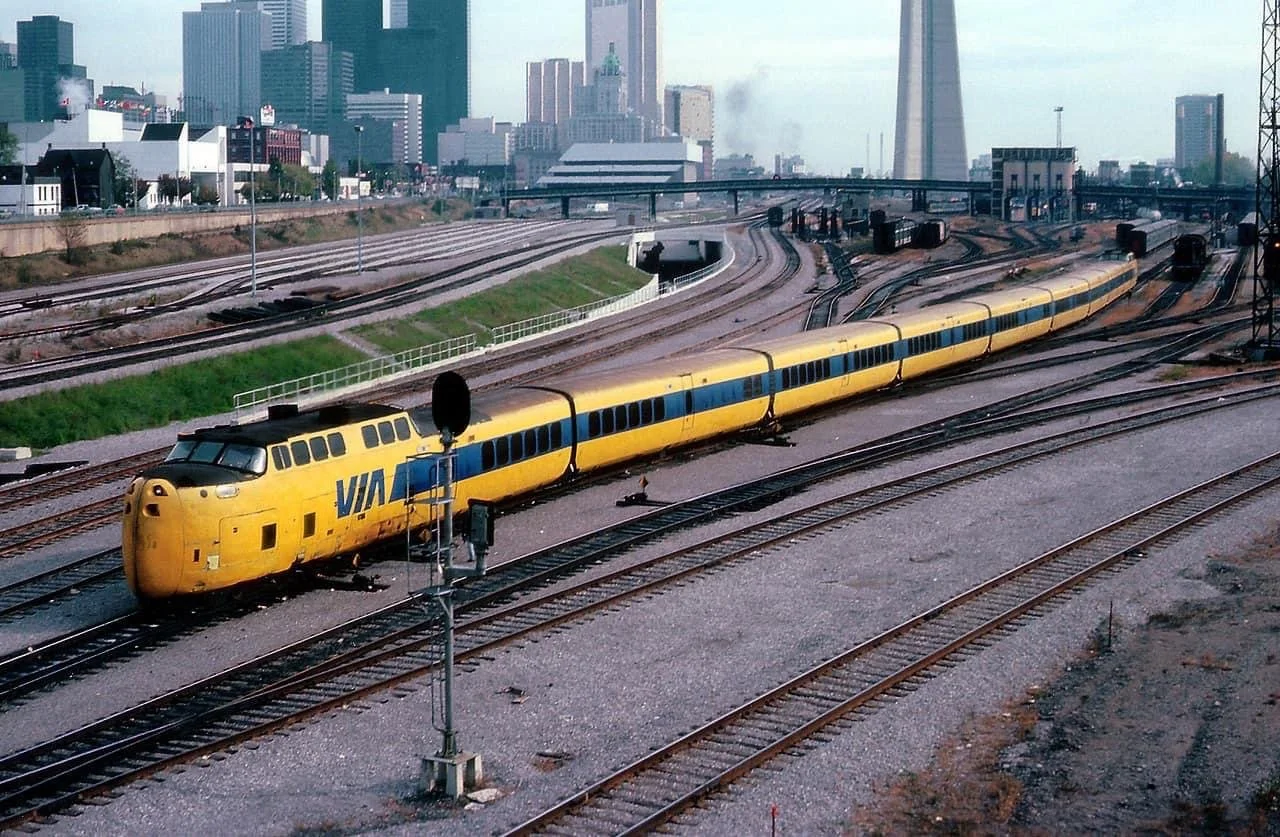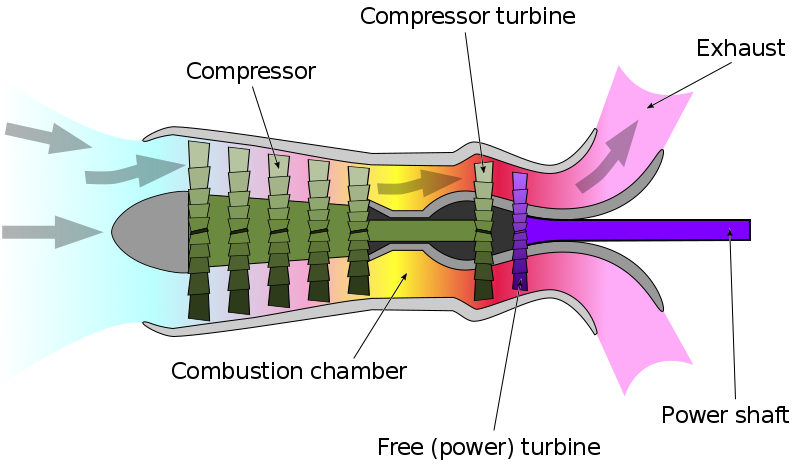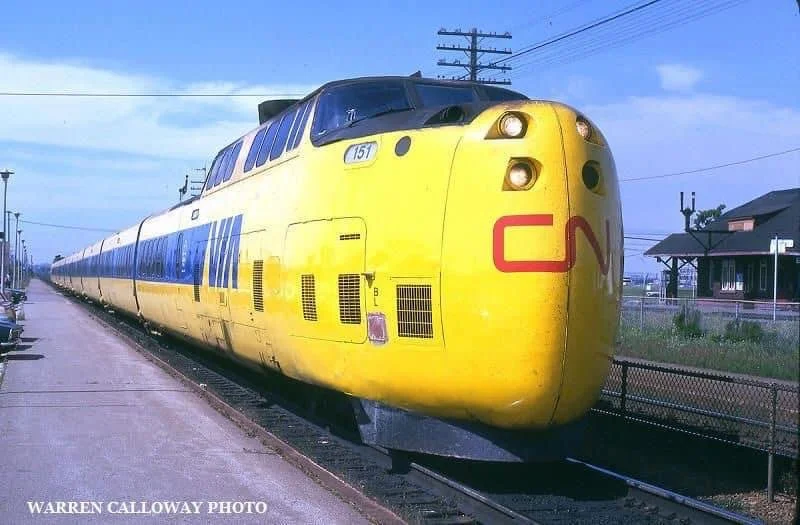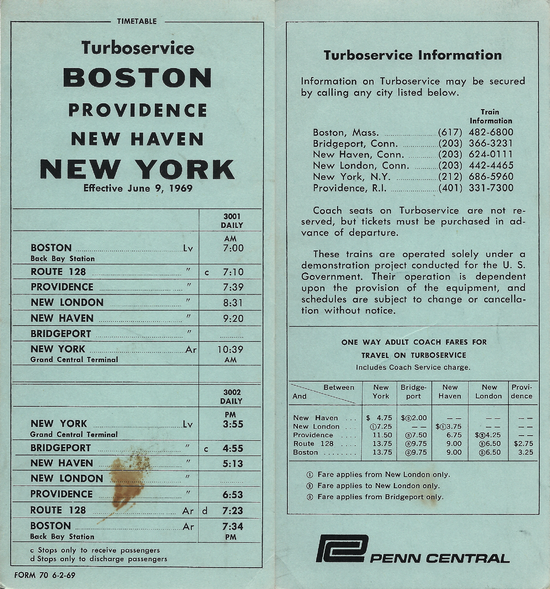Gas Turbine Powered Locomotive: UAC TurboTrain
In 1964, when Japanese National Railways began service on the original Tokaido Shinkansen Line; the service was topping out at 130mph. North America was taking notice at the effects that efficient regional passenger rail had on a Tokyo in the midst of its post-WWII economic rise. Specifically, the United Aircraft Corporation began construction of what would become their TurboTrain. Between 1967 and 1968, the UAC TurboTrain was one of the first gas-turbine-powered trains to enter service for passenger travel, as well as one of the first tilting trains to provide service in North America.
Propelling the locomotive at a max speed of 170mph is a modified Pratt & Whitney Canada ST6 providing the 7-car train set with 2,000 horsepower (1,491 kW), along with an additional 400 horsepower (298 kW) per engine. Powering these speeds is a turboshaft engine system, which is a form of gas turbine that is optimized to produce shaft horsepower rather than jet thrust. This type of engine is commonly found in applications that need high output and high efficiency. This includes being applied in the usage of lightweight propulsion such as; helicopters, hovercraft, and indeed the propulsion of the lightweight design of the TurboTrain.
However, the conception of the design dates back to the ‘50s. Thought the decade a series of design studies were carried out by the Chesapeake & Ohio (C&O) Railroad. C&O originally used Spain’s second generation Talgo design for inspiration and then modifying it for North American switchyards with engine of either side of the train set. The 1950s came to an end and research was ended. It wasn’t until 1965’s High Speed Ground Transportation Act that the design was brought up again for North American high speed service and UAC purchased C&O’s patent, as they made their own modifications to the design. UAC swapped out the diesel engine design for the use of an engine that is turbine powered. UAC implemented a design that produced the Power Dome Cars (PDC) with a longer control room ‘pod’ on top for more viewing area, along with additional seating. Overall, the 73’3” long cars are considerably shorter than the 85’ long conventional car average.
Though initially panned by Canadian journalists as having “rail noise that substantially exceeds that of standard equipment” and having cars that “negotiate curves in a series of short jerks rather than the smooth flowing motion promised In press releases.” Even so, TurboTrain service began in 1968 with lines running in both the US and Canada. In the US, the equipment ran at a max 100mph on the Boston-NYC corridor. Throughout the 1970s, as Amtrak took over the passenger industry; the TT briefly ran on routes from Washington DC to Chicago via West Virginia and Ohio. In 1976, Amtrak ceased revenue runs of TT train sets and transported them to Providence, RI for pending sales to Canadian Railways with remaining cars being disposed of in 1980.
The locomotive had a little more luck in Canada with CNR first ordering five seven-car TurboTrains for the Montreal-Toronto route. Some years later, in 1976, the train reached a Canadian record 140mph near Gananoque, ON, but the average overall on the route was 85.4. Putting the TT way under worldwide high speed standards. From brake lines freezing to multiple fires to the train sets occurring; when VIA Rail took over operations of the locomotives they were already known for being unreliable despite the equipment’s rather short history. At the dawn of the 1980s only two train sets remained in service, so it was the Turbo’s final run was on Halloween Day 1982.
The UAC TurboTrain’s downfall was inevitable, however it was preventable. Cars became an ever more popular choice of transportation in both the US and Canada. According to the Department of Energy, between 1970 and 1980 American households with two or more vehicles increased from 34.8% to 51.5%. Heck, when the original idea for this train was made nearly 79% of US households owned fewer than two vehicles. Furthermore, political leanings in both countries to freight rail gave priority to freight trains over passenger services; even when it came to bending the regulations made to prevent such a scenario. Specifically in the US, cutting public funds to public transport, promoting car dependency, the further building of highways, and the forgoing of general rail maintenance and cutting services was what made for the US’s less-than-decade run of the TurboTrain. Such is US passenger rail. All the while, these days Japanese Shinkansen lines operate at a max of 186mph, with select corridors maxing out at 200mph. Meanwhile, in the US; Amtrak’s Acela is the only true high-speed rail service, maxing at 150mph on the almost 50 mile stretch of the Northeast coridor route. Fortunately, 160mph speeds are in sight with Amtrak’s equipment 2024 upgrades.






